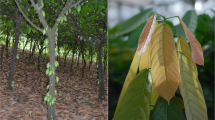Abstract
We evaluated the effects of planting densities (500, 1,000, 1,500 and 2,000 trees·ha−1) on tree growth performance (diameter at base, diameter at breast height, and clear bole height) of two clones (RRIM 2020 and RRIM 2025) of nine years old plantations of rubber tree (Hevea brasiliensis Muell. Arg) in Malaysia. For the four planting densities of the two clones, basal area and diameter at breast height declined with increasing planting density. Clear bole heights were greatest at 1,500 trees·ha−1 and lowest at 500 trees·ha−1 for the clone RRIM 2020, and at 2,000 trees·ha−1 and 500 trees·ha−1 for clone RRIM 2025. We conclude that the ideal planting density is 2,000 trees·ha−1 for obtaining high volume of wood production and 500 trees·ha−1 for high wood quality.
Similar content being viewed by others
References
Akram Nasir M, Aziz A, Mohar TA, Abdul Rehman M, Ahmad S. 2006. Effect of planting distance on tree growth and fruit quality of shamber grape fruit under agro climatic conditions of Sargodha. J Agric Res, 44(4): 353–358.
Alfred BR. 2007. Structure of stressed and non-stressed wood of Acacia hybrid and its relation to physical properties. Ph. D thesis, Universiti Putra Malaysia, 227 p.
Anonymous. 2010. Weather station report. Tok dor, Mini Station of Rubber Research Institute of Malaysia (RRIMINIS), Terengganu.
Ballard LA, Long NJ. 1988. Influence of stand density on log quality of lodgepole pine. Can J For Res, 18(7): 911–916.
Bamber RK, Burley J. 1983. The wood properties of radiate pine. Slough, England: Commonwealth Agricultural Bureaux.
Brown C. 2000. The global outlook for future wood supply from forest plantations: Global Forest Products Outlook Study. FAO Paper. Working Paper Series. Working Paper No: GFPOS/WP/03.
Viale delle Terme di Caracalla, 00100 Rome, Italy (Food and Agriculture Organization of the United Nations): 156.
Chadha KL. 2001. Hand book of Horticulture; Orchard planting and layout. New Delhi, ICAR. 1031.
Cockerham ST. 2004. Irrigation and planting density affect River Red Gum growth. California Agriculture, 58(1): 40–43
Fangs S, Li GY, Fu XX. 2004. Biomass production and bark yield in the plantations of Pteroceltis tatarinowii. Biomass & Bioenergy, 26(4): 319–328.
Grote R, Pretzsch H. 2002. A model for individual tree development based on physiological processes. Plant Biology, 4: 167–180.
Hein S, Weiskittel AR, Kohnle U. 2008. Effect of wide spacing on tree growth, branch and sapwood properties of young Douglas-fir (Pseudotsuga menziesii (Mirb.) Franco) in south-western Germany. European Journal of Forest, 127: 481–493.
IRRDB. 2008. Rubberwood section (the International Rubber Research and Development Board). Available at http://www.irrdb.com. [Retrieved 20.02.2011]
Kenk G. 1990. Wide spacing in Norway spruce stands. Development and consequences. Forstw Cbl, 109: 86–100 (in German with English summary).
Kerr G. 2003. Effects of spacing on the early growth of planted Fraxinus excelsior L. Can J For Res, 33: 1196–1207.
Lei H, Gartner LB, Milota MR. 1997. Effect of growth rate on the anatomy, specific gravity, and bending properties of wood from 7-year-old red alder (Alnus rubra). Can J For Res, 27: 80–85.
Mohd Izham BY. 2001. Quality assessment of two timbre latex clones of Rubberwood (Hevea brasiliensis). Masters Thesis, Universiti Putra Malaysia.
Naji HR, Sahri MH, Nobuchi T, Bakar ES. 2011. The effect of growth rate on wood density and anatomical characteristics of rubberwood (Hevea brasiliensis Muell. Arg.) in two different clonal trails, J Nat Prod Plant Resour, 1(2): 71–80.
Niemisto P. 1995. Influence of initial spacing and row-to-row distance on the crown and branch properties and taper of silver birch (Betula pendula). Scand J For Res, 10: 235–244.
Nobuchi T, Sahri MH. 2008. The Formation of Wood in Tropical Forest Trees: A challenge from the perspective of functional wood anatomy. Malaysia, Penerbit Universiti Putra Malaysia, p. 186.
Ogata Y, Nobuchi T, Fujita M, Sahri MH. 2001. Growth rings and tree growth in young para rubber trees from Peninsular Malaysia. IAWA journal, 22(1): 43–56.
Pérez Corderoa LD, Kanninenc M, Ugalde LA. 2003. Stand growth scenarios for Bombacopsis quinata plantations in Costa Rica. Forest Ecology and Management, 174: 345–352.
Pretzsch H. 2005. Stand density and growth of Norway spruce (Picea abies [L.] Karst.) and European beech (Fagus sylvatica L.): evidence from longterm experimental plots. Eur J For Res, 124(3): 193–205.
Rodrigo, VHL, Silva TUK, Munasinghe ES. 2004. Improving the spatial arrangement of planting rubber (Hevea brasiliensis Muell. Arg.) for longterm intercropping. Field Crops Research, 89: 327–335.
Scott W, Meade R, Leon R. 1998. Planting density and tree-size relations in coast Douglas-fir. Can J For Res, 28: 74–78.
Shigematsu A, Mizoue N, Kajisa T, Yoshida S. 2011. Importance of rubberwood in wood export of Malaysia and Thailand. New Forests, 41: 179–189.
Tuberman L. 2007. Rubber Wood — Plantation Grown Wood. Available at http://EzineArticles.com [Retrieved 18.04.2011]
Wei HY, Wang Y, Wang Z, Yan X. 2005. Effect of planting density on plant growth and camptothecin content of Camptotheca acuminate seedlings. Journal of Forestry Research, 16(2): 137–139.
Zhu JY, Tim Scott C, Scallon K. 2007. Effects of plantation density on wood density and anatomical properties of Red Pine (Pinus resinosa Ait.). Wood and Fiber Science Journal, 39(3): 502–512.
Zobeiry M. 2005. Forest Inventory (Measurment of Tree and Forest). Tehran: University of Tehran Press, p. 401.
Zobel BJ, Van Buijtenen JP. 1989. Wood Variation; Its Causes and Control. Berlin: Speringer-Verlag, P. 363.
Author information
Authors and Affiliations
Corresponding author
Rights and permissions
About this article
Cite this article
Naji, H.R., Sahri, M.H. Intra- and inter-clonal tree growth variations of Hevea brasiliensis . Journal of Forestry Research 23, 429–434 (2012). https://doi.org/10.1007/s11676-012-0280-2
Received:
Accepted:
Published:
Issue Date:
DOI: https://doi.org/10.1007/s11676-012-0280-2




